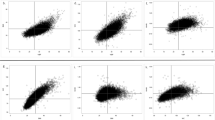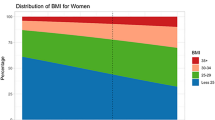Abstract
Context:
Obesity poses a significant health risk, but health risk is not equivalent to actual health status. Further, age and gender might alter the effect of body weight on physical health.
Objective:
To determine the relationship between body mass index (BMI), age, gender and current health status.
Design:
Data from the 1988–1994, 2003–2004 and 2005–2006 National Health & Nutrition Examination Surveys were weighted to represent the US population. BMI, age, gender and current medication use were analyzed in a sample-adjusted 9071 women and 8880 men.
Main Outcome Measures:
The percentage of participants taking medication and the total number of medications taken.
Results:
In both the 1988–1994 and 2003–2006 data sets, with few exceptions, medication loads did not increase significantly in overweight compared with normal-weight people. Medication loads increased significantly in obese compared with normal-weight people aged 40+, but only marginally at 25–39 years. Medication loads were higher in women than men, but significantly less so in people aged 55–70.
Conclusions:
First, medication loads, a measure of current health status, were increased in obese compared with the normal-weight people, but the effect was mainly at ages over 40 years. In addition, BMI category contributed less to medication loads at ages 25–39 than in older groups. Second, there was little difference in current health status in normal-weight versus overweight people at all ages. Finally, higher medication loads in women than men are more apparent in younger than older people. Although obesity does not substantially affect current health in young people, it is likely that the increased medication loads in obese compared with normal-weight older people originates at least in part from an increased BMI starting at a younger age. Thus, age, gender and onset of high BMI all require consideration when using BMI to assess current health status.
This is a preview of subscription content, access via your institution
Access options
Subscribe to this journal
Receive 12 print issues and online access
$259.00 per year
only $21.58 per issue
Buy this article
- Purchase on Springer Link
- Instant access to full article PDF
Prices may be subject to local taxes which are calculated during checkout


Similar content being viewed by others
References
Flegal KM, Carroll MD, Ogden CL, Johnson CL . Prevalence and trends in obesity among US adults, 1999–2000. JAMA 2002; 288: 1723–1727.
Hossain P, Kawar B, El Nahas M . Obesity and diabetes in the developing world—a growing hallenge. N Engl J Med 2007; 356: 13–215.
Pitner JK . Obesity in the elderly. Consul Pharm 2005; 20: 498–513.
Hu G, Qiao Q, Tuomilehto J, Balkau B, Borch-Johnsen K, Pyorala K, DECODE Study Group. Prevalence of the metabolic syndrome and its relation to all-cause and cardiovascular mortality in nondiabetic European men and women. Arch Intern Med 2004; 164: 1066–1076.
Allison DB, Fontaine KR, Manson JE, Stevens J, VanItallie TB . Annual deaths attributable to obesity in the United States. JAMA 1999; 282: 1530–1538.
McTigue K, Larson JC, Valoski A, Burke G, Kotchen J, Lewis CE et al. Mortality and cardiac and vascular outcomes in extremely obsess women. JAMA 2006; 296: 79–86.
Muennig P, Lubetkin E, Jia H, Franks P . Gender and the burden of disease attributable to obesity. Am J Public Health 2006; 96: 1662–1668.
Seidell JC, Bakx KC, Deurenberg P, Burema J, Hautvast JG, Huygen FJ . The relation between overweight and subjective health according to age, social class, slimming behavior and smoking habits in Dutch adults. Am J Public Health 1986; 76: 1410–1415.
Buckley BM . Healthy ageing: ageing safely. Eur Heart J 2001; 3 (Suppl N): N6–N10.
Crews DE . Senescence, aging, and disease. J Physiol Anthropol 2007; 26: 365–372.
Stowell JR, Hedges DW, Ghambaryan A, Key C, Bloch GJ . Validation of the Symptoms of Illness Checklist (SIC) as a tool for health psychology research. J Health Psychol 2009; 14: 64–73.
Katz JN, Chang LC, Sangha O, Fossel AH, Bates DW . Can comorbidity be measured by questionnaire rather than medical record review? Med Care 1996; 34: 73–84.
Papakostas GI . Limitations of contemporary antidepressants: tolerability. J Clin Psychiatry 2007; 68 (Suppl 10): 11–17.
Ferraro KF, Booth TL . Age, body mass index, and functional illness. J Gerontol B Psychol Sci Soc Sci 1999; 54: S339–S348.
Flegal KM, Graubard BI, Williamson DF, Gail MH . Excess deaths associated with underweight, overweight, and obesity. JAMA 2005; 293: 1861–1867.
Reynolds MW, Fredman L, Langenberg P, Magaziner J . Weight, weight change, mortality in a random sample of older community-dwelling women. J Am Geriatr Soc 1999; 47: 1409–1414.
Villareal DT, Apovian CM, Kushner RF, Klein S . Obesity in older adults: technical review and position statement of the American Society for Nutrition and NAASO, the Obesity Society. Obes Res 2005; 13: 1849–1863.
Zamboni M, Mazzali G, Zoico E, Harris TB, Meigs JB, Di Francesco V et al. Health consequences of obesity in the elderly: a review of four unresolved questions. Int J Obes 2005; 29: 1011–1029.
Newcomer JW . Metabolic considerations in the use of antipsychotic medications: A review of recent evidence. J Clin Psych 2007; 68 (Suppl 1): 20–27.
NHANES Lexicon Plus. http://www.cdc.gov/nchs/data/nhanes/nhanes_05_06/rxq_rx_d.pdf.
Haddad PM, Das A, Ashfaq M, Wieck A . A review of valproate in psychiatric practice. Expert Opin Drug Metab 2009; 5: 539–551.
Goldsmith DR, Wagstaff AJ, Ibbotson T, Perry CM . Lamotrigine: a review of its use in bipolar disorder. Drugs 2003; 63: 2029–2050.
STATA 10 Base Reference Manual. Stata Press: College Station,TX., USA, 2007. vol 3, pp 581–586.
Erdman D, Jackson L, Sinko A . Zero-inflated Poisson and negative binomial models using the COUNTREG procedure. Proc, SAS Global Forum 2008. Paper 322 (11 pages). (SAS Institute, Cary, NC) (http://www2.sas.com/proceedings/forum2008/322-2008.pdf).
DeLongis A, Folkman S, Lazarus RS . The impact of daily stress on health and mood: psychological and social resources as mediators. J Pers Soc Psychol 1988; 54: 486–495.
Hale WE, Perkins LL, May FE, Marks RG, Stewart RB . Symptom prevalence in the elderly an evaluation of age, sex, disease, and medication use. J Am Geriatr Soc 1986; 34: 333–340.
Ritchey FJ, La Gory M, Mullis J . Gender differences in health risks and physical symptoms among the homeless. J Health Soc Behav 1991; 32: 33–48.
Vahtera J, Kivimèaki M, Vèaèanèanen A, Linna A, Pentti J, Helenius H et al. Sex differences in health effects of family death or illness: are women more vulnerable than men? Psychosom Med 2006; 68: 283–291.
Verbrugge LM . Multiple roles and physical health of women and men. J Health Soc Behav 1983; 24: 16–30.
Moyad MA . Current methods used for defining, measuring, and treating obesity. Semin Urol Oncol 2001; 19: 247–256.
Forbes GB . Stature and lean body mass. Am J Clin Nutr 1974; 27: 595–602.
Campbell NR, Brant R, Johansen H, Walker RL, Wielgosz A, Onysko J et al. Canadian hypertension education program outcomes research task Force Increases in antihypertensive prescriptions and reductions in cardiovascular events in Canada. Hypertension 2009; 53: 128–134.
Grijalva CG, Chung CP, Stein CM, Mitchel Jr EF, Griffin MR . Changing patterns of medication use in patients with rheumatoid arthritis in a Medicaid population. Rheumatology 2008; 47: 1061–1064.
Ma J, Lee KV, Stafford RS . Changes in antihypertensive prescribing during US outpatient visits foruncomplicated hypertension between 1993 and 2004. Hypertension 2006; 48: 846–852.
Smith MA, Cox ED, Bartell JM . Overprescribing of lipid lowering agents. Qual Saf Health Care 2006; 15: 251–257.
Acknowledgements
We acknowledge Brian Wells, Mike Talley and Joe Olsen of Brigham Young University, and Daniel Bloch of Stanford University, for their help with statistical analyses. No compensation was received for their work. The research presented herein was supported by funds from Brigham Young University for the conduct of the study, data collection, management and analysis, and preparation of the paper.
Author information
Authors and Affiliations
Corresponding author
Additional information
Author contributions
George Bloch and Brant Jarrett had full access to all the data in the study and take responsibility for the integrity of the data and the accuracy of the data analysis. Brant Jarrett contributed to the conception and design of the study, data acquisition, analysis and interpretation, statistical analysis, supervision, and drafting and critical revision of the paper. George J Bloch contributed to the conception and design of the study, data acquisition, analysis and interpretation, statistical analysis, supervision, funding, administrative and technical support, and drafting and critical revision of the paper. Danny Bennet and Brock Bleazard contributed to the data acquisition, analysis and interpretation, and statistical analysis. Dawson Hedges contributed to the conception and design of the study, the analysis and interpretation of the data, and the drafting and critical revision of the paper.
Rights and permissions
About this article
Cite this article
Jarrett, B., Bloch, G., Bennett, D. et al. The influence of body mass index, age and gender on current illness: a cross-sectional study. Int J Obes 34, 429–436 (2010). https://doi.org/10.1038/ijo.2009.258
Received:
Revised:
Accepted:
Published:
Issue Date:
DOI: https://doi.org/10.1038/ijo.2009.258



